Discover 11 hidden attractions, cool sights, and unusual things to do in Tarrytown (United States). Don't miss out on these must-see attractions: Tarrytown Music Hall, Lyndhurst Mansion, and Foster Memorial AME Zion Church. Also, be sure to include Reformed Church of the Tarrytowns in your itinerary.
Below, you can find the list of the most amazing places you should visit in Tarrytown (New York).
Table of Contents
Tarrytown Music Hall

Live music venue in Tarrytown, New York. The Music Hall, in Tarrytown, New York, United States, is located on West Main Street downtown. It is a brick structure in the Queen Anne architectural style erected in the late 19th century. In 1980, it was listed on the National Register of Historic Places.
It is the oldest theater in Westchester County still used as a theater, and considered one of the county's finest non-residential applications of the Queen Anne Style. In 1901 it was one of the first theaters to show the new form of entertainment called motion pictures. Dave Brubeck, Louis Armstrong and Miles Davis are among the musicians who have performed there. Many classical music performances have been recorded there to take advantage of its excellent acoustics. It is one of only 6% of theaters in the United States built before 1900.
It closed in 1976 due to neglect and structural problems. Shortly after it was listed on the Register, a local not-for-profit bought it and restored it. It has remained in operation since it was reopened a few years later, with several other renovations. More notable artists have performed there since then and it has been used in several films and television commercials.[1]
Address: 13 Main Street, Tarrytown
Lyndhurst Mansion
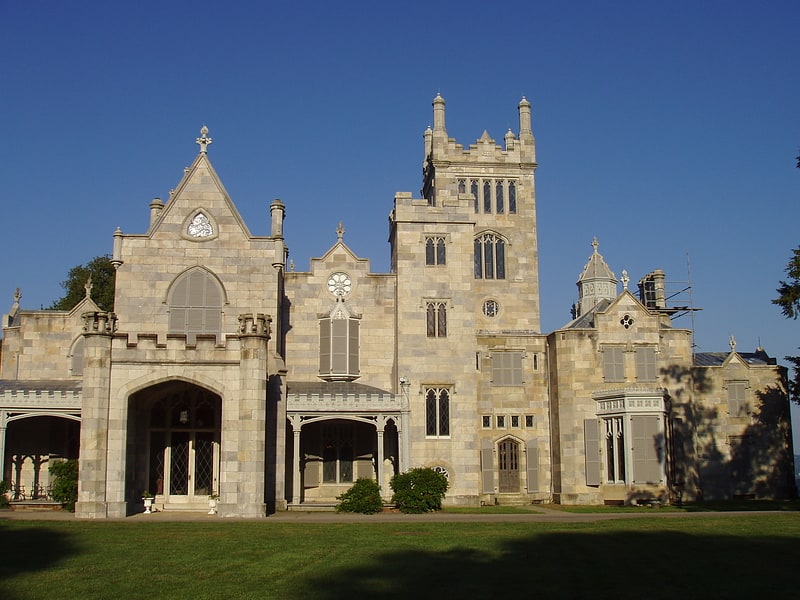
Historical place museum in Tarrytown, New York. Lyndhurst, also known as the Jay Gould estate, is a Gothic Revival country house that sits in its own 67-acre park beside the Hudson River in Tarrytown, New York, about a half mile south of the Tappan Zee Bridge on US 9. The house was designated a National Historic Landmark in 1966.[2]
Address: 635 S Broadway, Tarrytown
Foster Memorial AME Zion Church
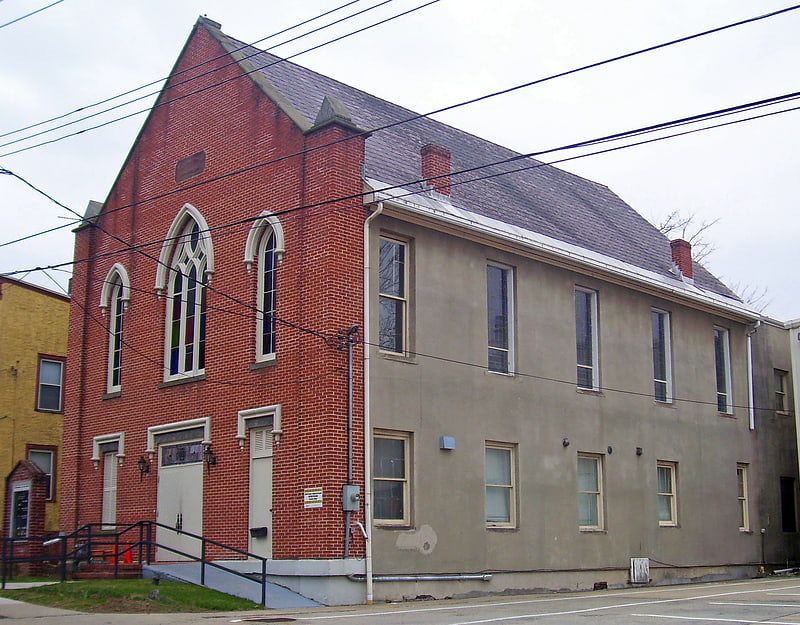
Church in Tarrytown, New York. The Foster Memorial AME Zion Church is located on Wildey Street in Tarrytown, New York, United States. Formed in 1860, it is the oldest black church in Westchester County and possibly one of the oldest in the state. During the Civil War it was a stop on the Underground Railroad. One of the church's founders was herself an escaped slave, as were many parishioners. They helped slaves either continue to Canada or settle in Tarrytown if they wished. The church has played a major role in Tarrytown's African-American community ever since.
The church's brick building, designed by local architect James Bird, was opened in 1865. It was added to the National Register of Historic Places in 1982.[3]
Reformed Church of the Tarrytowns
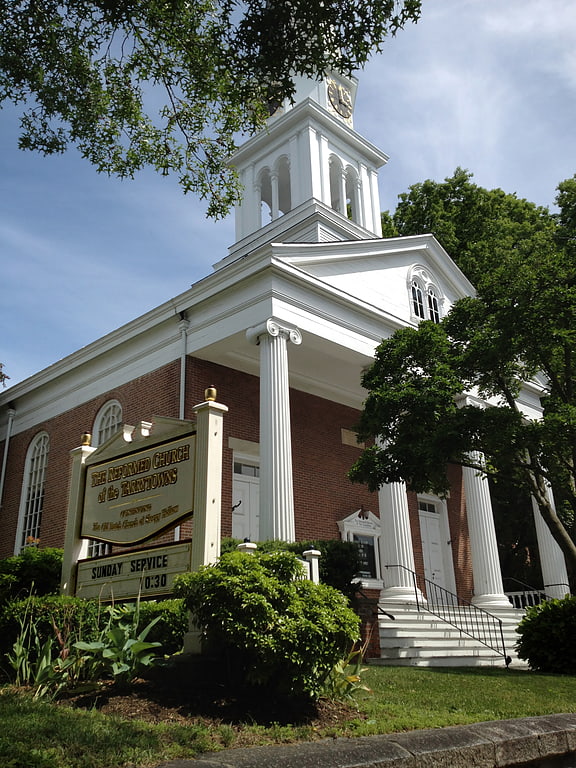
The Reformed Church of the Tarrytowns in Tarrytown, New York, serves both Tarrytown and Sleepy Hollow, New York. It was constructed in 1837 as an extension of the Old Dutch Church of Sleepy Hollow to serve the Tarrytown community.
The new community of Dutch Reformed would have had its own Elders and Deacons and shared a minister with the Old Dutch Church of Sleepy Hollow. That church has a similar arrangement with the Dutch Reformed at Cortlandt Manor dating from 1697 when the Sleepy Hollow community was first recorded as established, though the structure had been completed in 1685 and the community had been there for long before. The Cortlandt Manor community had its own Elders and Deacons but recognized the community at Sleepy Hollow as its head, and regularly went down to the village for services and to record their births and marriages.
The community at Tarrytown became independent from Sleepy Hollow in the 1850s and soon after dropped the “Dutch” association from its name. As the Sleepy Hollow community diminished and the Old Dutch Church of Sleepy Hollow became less used, the Tarrytown community adopted the name for their landmark church the Reformed Church of the Tarrytowns, adding that it was a “continuation of the Old Dutch Church of Sleepy Hollow.”
Presenting an impressive façade on North Broadway, the structure's steeple remains the highest point on North Broadway and the tallest physical structure in Tarrytown, despite not being built on the heights of the city. The church's porch of four columns supporting an extended pediment offers a refined architectural addition to the business district of historic Tarrytown.[4]
Sunnyside
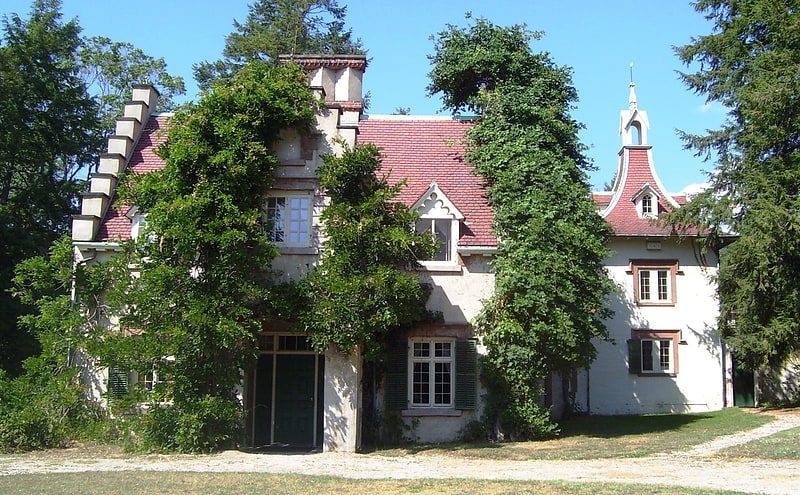
Sunnyside is a historic house on 10 acres along the Hudson River, in Tarrytown, New York. It was the home of the American author Washington Irving, best known for his short stories, such as "Rip Van Winkle" and "The Legend of Sleepy Hollow".
This cottage-like estate, designated a National Historic Landmark in 1962, reflects Dutch Colonial Revival, Scottish Gothic, and Tudor Revival influences, with its wisteria-covered entrance and jagged crow-stepped gable.[5]
Address: 3 W Sunnyside Lane, Irvington, Tarrytown
First Baptist Church of Tarrytown
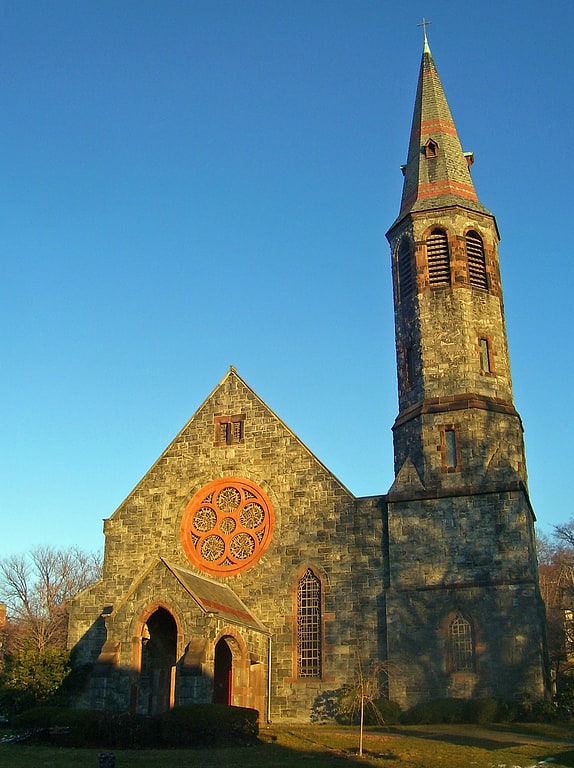
Building in Tarrytown, New York. The First Baptist Church of Tarrytown is located on South Broadway in Tarrytown, New York, United States. It is a stone building in the Victorian Gothic architectural style dating to the 1870s. In 1983 it and its rectory were listed on the National Register of Historic Places.
Congregants first met in the 1840s. The first church on the present site was erected in 1847. A quarter-century later Russell Sturgis was commissioned to design the present structure, which took five years to complete, including a detailed Gothic interior. It signaled Tarrytown's development as a suburb, especially after John D. Rockefeller and members of his family moved to the village and joined the church. They made possible some of its later enhancements, such as its landscaping and rectory, both added later.[6]
Christ Episcopal Church
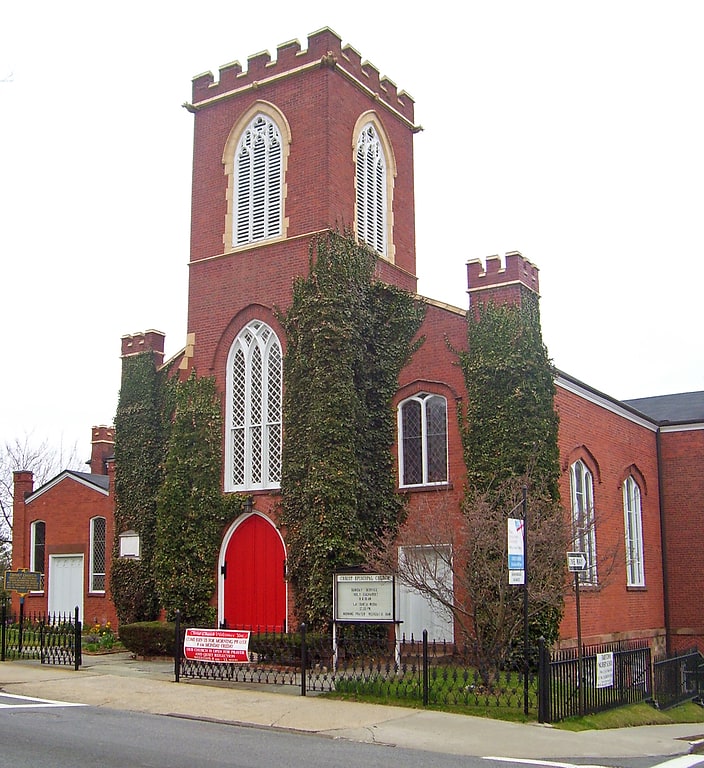
Church in Tarrytown, New York. Christ Episcopal Church is a historic Episcopal church located at 43 South Broadway in Tarrytown, New York. Topped by a modest tower, the ivy-covered red brick church was built in 1837 and maintains an active congregation to the present day. The church also includes the San Marcos Mission, a Spanish-language ministry.
It was recognized as a landmark by the New York Department of Education in 1935. In 1987 it was added to the National Register of Historic Places for both its association with early American author Washington Irving, who served as a vestryman, and its distinctive early Gothic Revival architecture. It has undergone several extensive renovations since its construction, and has had two outbuildings added, but maintains its historic character.[7]
Tarrytown Light
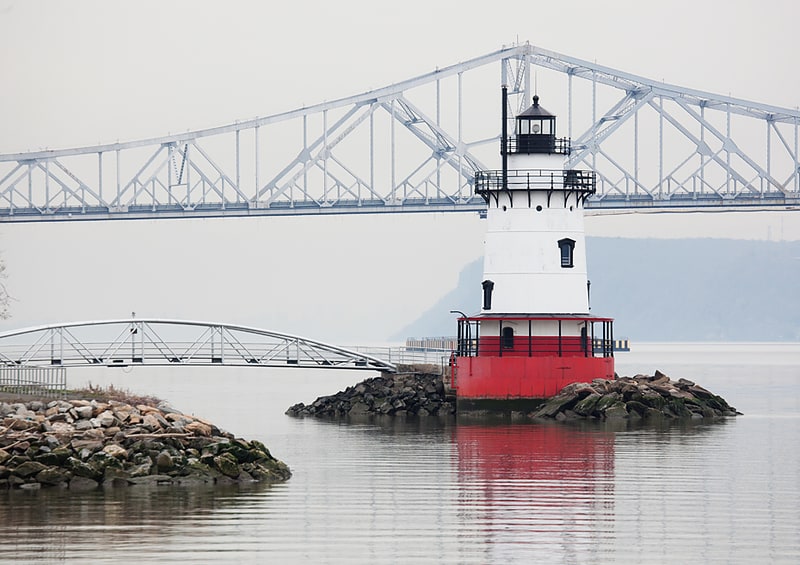
Lighthouse in Sleepy Hollow, New York. Tarrytown Light, also known as Kingsland Point Light and Sleepy Hollow Light, is a sparkplug lighthouse on the east side of the Hudson River in Sleepy Hollow, New York, United States. It a conical steel structure erected in the 1880s. In 1979 it was listed on the National Register of Historic Places.
The need for a lighthouse to warn ships away from the shoals near the common route off Tarrytown and Ossining had been obvious by the mid-19th century. But high land values at two favored locations led the federal government to instead build it 1⁄2 mile (0.80 km) offshore. It was the only family station on the lower Hudson, the only conical steel lighthouse on the Hudson to have living quarters within it rather than attached to it, and the only lighthouse in Westchester County. It remained in use until the mid-20th century; the construction of the Tappan Zee Bridge on the shoals where it stood and the development of the General Motors Tarrytown Truck Assembly plant on land reclaimed from the river to its east made the light obsolete. Today it is part of a county park, and tours are available.[8]
Patriot's Park
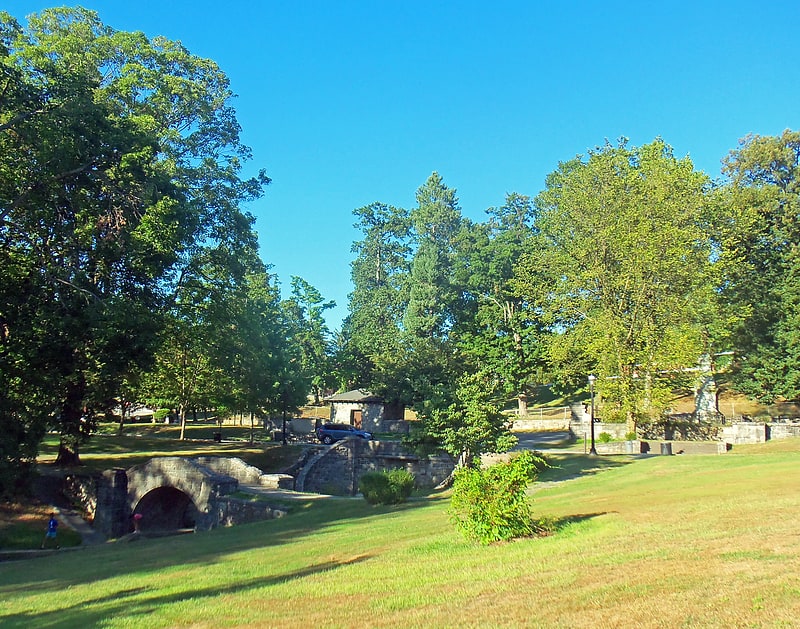
Park in Tarrytown, New York. Patriot's Park is located on U.S. Route 9 along the boundary between Tarrytown and Sleepy Hollow in Westchester County, New York, United States. It is a four-acre parcel with a walkway and several monuments. In 1982 it was added to the National Register of Historic Places.[9]
Address: 121 N Broadway, Tarrytown
Edward Harden Mansion
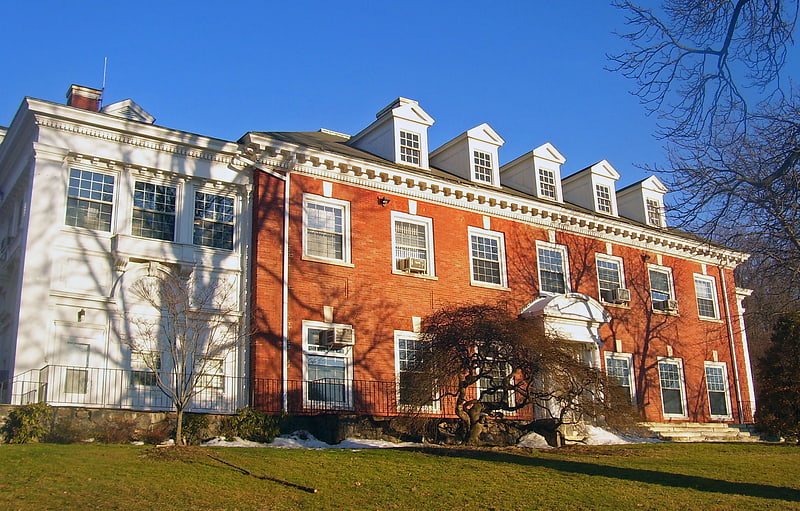
Building in Sleepy Hollow. The Edward Harden Mansion, also known as Broad Oaks, is a historic home located on North Broadway in Sleepy Hollow, New York, United States, on the boundary between it and neighboring Tarrytown. It is a brick building in the Georgian Revival style designed by Hunt & Hunt in the early 20th century, one of the few mansions left of many that lined Broadway in the era it was built. Also on the property is a wood frame carriage house that predates it slightly. Both buildings were listed on the National Register of Historic Places in 2003.
Edward Harden had earned fame and fortune as the Chicago Tribune reporter who broke the story of Admiral George Dewey's victory in the Battle of Manila Bay. He later left journalism for finance, and after earning a seat on the New York Stock Exchange commissioned the house. Shortly after it was built, he allowed part of the home to be used for a new kindergarten that was the first Montessori school in the U.S. The Harden family later moved to nearby Scarborough. It was used as a home for retired seamstresses and, in the middle of the century, sold to the local school district, which continues to use it as its main offices today.[10]
North Grove Street Historic District

The North Grove Street Historic District is located along the north end of that street in Tarrytown, New York, United States. It consists of five mid-19th century residences, on both sides of the street, and a carriage barn. In 1979 it was listed on the National Register of Historic Places.
The houses were built by wealthy residents in the middle of the 19th century, in the Second Empire, Gothic Revival, and Italianate architectural styles, when the area offered a view of the Hudson River to the west. Three were built by Jacob Odell, Tarrytown's first village president, and his descendants. They share some common architectural elements, and have survived relatively intact. Today three remain as private residences while the other two are home to the Tarrytown Historical Society.[11]